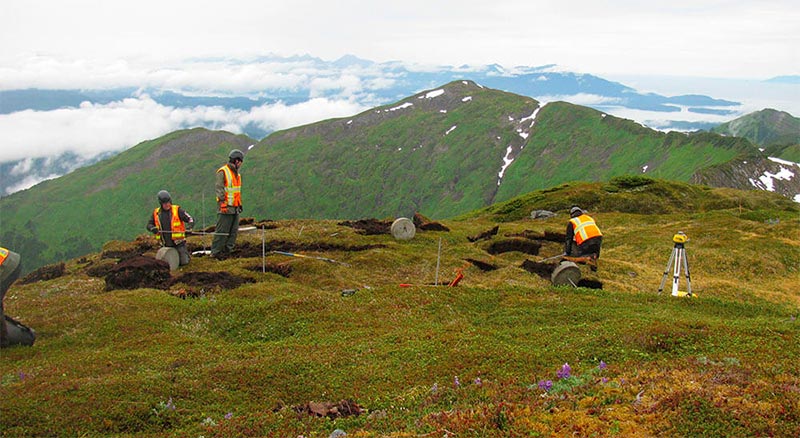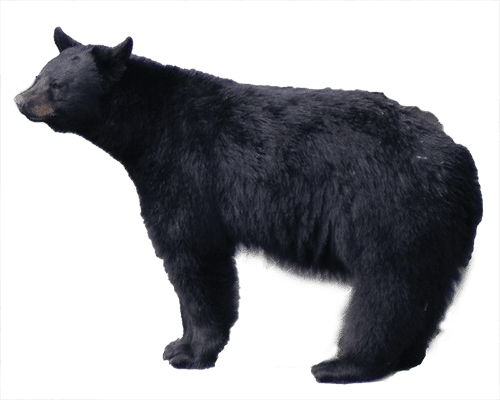
Working in Alaska’s extreme environment is not without challenge. Like working on top of a 3,400-foot mountain, surrounded by the highest concentration of black bears in the world. Or 350 miles from the nearest supply point, in an area notorious for nasty weather and williwaw winds.
Not only do Ahtna employees overcome these environmental challenges every day, they work smart, invent cool, new solutions to complex problems and get the work done on-time, on-budget and in a manner that exceeds our clients’ expectations.“Our employees are hands-down the very best in the world,” said Ahtna CEO Tom Maloney. “They’re the key to our success.”
Former Ahtna technical writer Karina Quintans has written two articles this year published in The Military Engineer, the journal of the Society of American Military Engineers (SAME), of which Ahtna is a member, that spotlight the amazing accomplishments of our employees. The stories are available in full by visiting www.same.org/tme. These summaries are published with permission of SAME.
One chance to get it right
Way out in the Aleutian Chain sits Atka, site of a World War II airfield that was built in 1942 and abandoned three years later after playing an important role in the “Thousand Mile War,” the fight for the Aleutian Islands that involved upward of half a million men and costing perhaps 10,000 lives. In early June of 1942, Dutch Harbor was bombed, and then, at the end of the Aleutian chain, the Japanese invaded and took control of the islands of Attu and Kiska.
Today, approximately 60, mostly Native Atkans, live in and around the 10-mile area where airfield operations once stood. What remains are the scars of abandoned infrastructure and an untold amount of contamination that Ahtna Engineering Services (AES), in partnership with the U.S. Army Corps of Engineers (USACE), needed to investigate and clean up.
Sources of contamination include above-ground storage tanks, drums, pipeline, generator houses, antennas, towers, radars, heated mess halls, radio/transmitter buildings. In short, 1,891 potential sources.
So how do you collect field data from that many potential sources when many of the facilities have long been demolished, the surface debris removed and all that remains are chest-high grass? The thought of completing over almost 2,000 pages of field forms and handwritten field notes collected under the near constant rain and wind conditions that characterize the Aleutian Island weather was simply unappealing, not to mention risky, given the possibility for multiple transcription errors.
The solution. An App for that
Instead Ahtna and team member Geosyntec Consultants developed an iPad application to collect and manage the data, built a customized database and designed a project website.
The solution reduced field equipment needs, improved data management/quality, provided daily updates, improved real-time decision-making, provided confidence that field data collection was complete prior to demobilizing, created “ready-to-go” digital appendices and eliminated the need to create/update the database upon return to the office.
Logistics on Atka are a nightmare. There is no gas station or hardware store, no hotels or hospitals. The nearest of these amenities is 350 miles away by air. Even cellular service is non-existent. Transport of personnel to the island is by small plane only, limited to three days a week and highly weather dependent. Across the 10 miles of the former airfield, most roads have deteriorated, so travel is primarily through all-terrain vehicles, utility task vehicles and trucks.
Extensive planning was required to mobilize equipment and supplies. Chartering a barge was the only option, and it is a costly one. A pickup truck, five utility task vehicles, 55-gallon drums of fuel, spill response materials, two Geoprobe drill rigs, sample coolers and glass wear, various field supplies and non-perishable foods were barged ahead of staff during each the field seasons.
Perishable food supplies were flown in every two week. A field office was established inside the local schoolhouse. A full-time cook prepared thrice-daily meals for the field team in the schoolhouse kitchen and team personnel stayed in adjacent houses normally occupied by teachers during the school year.
Our staff worked hard to make sure they were good neighbors. Ahtna invited the community to use project-chartered aircraft to move people and goods on and off the island. In turn, when the project was at a standstill waiting for hydraulic fluid for the drill rig to arrive, the local fish processing plant provided interim supplies.
Atka was a tough assignment but this complex project has been executed seamlessly and has been highly praised for quality, scheduling and cost control. The three-year project wrapped up this year.
AEI’s innovative foundation cuts costs, slashes installation time
Ahtna Environmental Inc. (AEI) went to the drawing board to develop an innovative foundation for remote communications facilities that reduces installation time by 60 percent and is now the standard for installations in the most challenging sites, like the top of high mountains.
AEI installed its innovative precast concrete “disk” foundation at a remote Self-Sustained Outlet (SSO) site in the mountains of Southeast Alaska two years ago. The Federal Aviation Administration (FAA) maintains hundreds of SSO radio communications facilities, which are designed to ensure the safety of aircraft in flight. SSOs in Alaska are often located on remote, unadorned mountain ridges referred to as “high sites.”
Under subcontract to Parsons Infrastructure & Technology Group, AEI supported the highly complex construction of a SSO atop a 3,400-foot mountain ridge on Kuiu Island, located in the Tebenkof Bay Wilderness Area of the Tongass National Forest in Southeast Alaska.
In addition to difficult weather conditions (near zero visibility at times due to heavy fog, winds over 80 mph, rain and snow) and lack of infrastructure, the location contains the highest concentration of black bears in the world.
It took detailed logistics planning to transport 68,000 pounds of materials, supplies and equipment from Anchorage to Petersburg, where it was loaded onto a barge, which was towed and anchored in Camden Bay, approximately 4 miles north of the project site. The barge was then double-anchored in a protected area of the bay and maintained as a staging area for the duration of the project.
Transportation from the barge to the mountaintop took 53 helicopters slings.
The nine-person field team (comprised of FAA, Parsons and Ahtna personnel) was housed onsite in four weatherproof and insulated 12-foot by 10-foot tents that were placed on a wooden floor and securely anchored with the high-wind anchoring devices. A subcontracted dedicated cook provided three meals a day.
AEI used an innovative value engineering design alternative for the structural foundations to condense the field schedule by 60 percent and reduce overall project costs. A typical foundation design would have required pouring concrete into 18-inch-diameter by 4-foot-tall columns. Instead, 124 precast, 18-foot by 6-inch foundations were produced in Anchorage and shipped to the site.
The design developed by Ahtna has multiple benefits, including minimizing risk in the foundation quality since site conditions are not always favorable for pouring concrete and avoiding the need to transport bags of concrete and additional heavy equipment to the site.

As a testimony to the dedicated team effort, the project was completed on time, on budget and with no safety incidents. FAA has since mandated that the AEI foundations be used on all similar “SSO high” sites.
Just another day of work for our fantastic employees who report to work under some of the world’s most challenging conditions.
